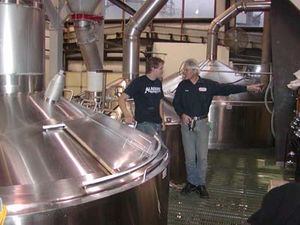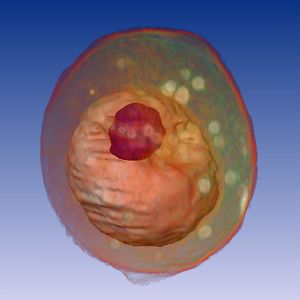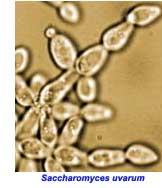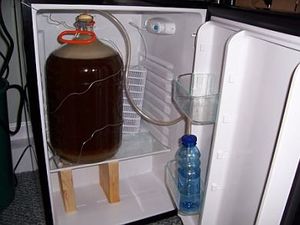Beer Fermentation Tanks: Difference between revisions
| Line 92: | Line 92: | ||
7. [http://www.beer-brewing.com/apex/brewers_yeast/ale_yeast.htm Goldammer, Ted. “The Brewers’ Handbook, The Complete Book to Brewing Beer”. December 2000. Chapter 4. "Ale Yeast"] | 7. [http://www.beer-brewing.com/apex/brewers_yeast/ale_yeast.htm Goldammer, Ted. “The Brewers’ Handbook, The Complete Book to Brewing Beer”. December 2000. Chapter 4. "Ale Yeast"] | ||
8. [http://www.beer-brewing.com/apex/beer_fermentations/beer_yeast.htm "Microbial Contamination."] | 8. [http://www.beer-brewing.com/apex/beer_fermentations/beer_yeast.htm Goldammer, Ted. “The Brewers’ Handbook, The Complete Book to Brewing Beer”. December 2000. Chapter 4. "Microbial Contamination."] | ||
9. [http://www3.interscience.wiley.com/cgi-bin/fulltext/10956/PDFSTART Dengis, Pascale B.; Rouxhet, Paul G. “Surface Properties of Top- and Bottom-Fermenting Yeast.” Yeast. 1997: 13: 931-943.] | 9. [http://www3.interscience.wiley.com/cgi-bin/fulltext/10956/PDFSTART Dengis, Pascale B.; Rouxhet, Paul G. “Surface Properties of Top- and Bottom-Fermenting Yeast.” Yeast. 1997: 13: 931-943.] | ||
| Line 98: | Line 98: | ||
10. [http://www3.interscience.wiley.com/cgi-bin/fulltext/118600354/PDFSTART . Anderson F. Cunha1, Silvia K. Missawa1, Luiz H. Gomes2, S´ ergio F. Reis3 & Gonc¸alo A. G. Pereira.” Control by sugar of Saccharomyces cerevisiae flocculation for industrial ethanol production.” FEM Yeast Research. March 2006:6:2:280-287.] | 10. [http://www3.interscience.wiley.com/cgi-bin/fulltext/118600354/PDFSTART . Anderson F. Cunha1, Silvia K. Missawa1, Luiz H. Gomes2, S´ ergio F. Reis3 & Gonc¸alo A. G. Pereira.” Control by sugar of Saccharomyces cerevisiae flocculation for industrial ethanol production.” FEM Yeast Research. March 2006:6:2:280-287.] | ||
11. [http://en.wikipedia.org/wiki/Wort_(brewing)"Wort".] | 11. [http://en.wikipedia.org/wiki/Wort_(brewing)"Wort". ''Wikipedia'' 25 August 2008. ] | ||
12. Bagajewicz, Miguel J., Preedy, Victor R., Watson, Ronald R. Reviews in Food and Nutrition Toxicity, Volume 2: Toxic and Pathological Aspects. CRC Press, 2004. | 12. Bagajewicz, Miguel J., Preedy, Victor R., Watson, Ronald R. Reviews in Food and Nutrition Toxicity, Volume 2: Toxic and Pathological Aspects. CRC Press, 2004. | ||
Revision as of 04:50, 3 September 2008
Description of Niche
Physical conditions
Beer fermentation tanks are vessels of various size usually made from stainless steel that contain a mixture of malted grain, hops, yeast and water to create a liquid collectively known in the brewing process as wort. Fermentation tanks vary in temperature depending upon the beer being produced. Ales typically ferment at high temperatures from 10-25°C (50-77°F) while lagers ferment at a cold temperature from 7-15°C (45-59°F) (15). The wort is acidic in order to catalyze the fermentation process which will continue to drop the initial pH from 5.2 to a final pH of 4 as the wort ferments (16).
Influence by adjacent communities
Commercial brewing is typically done in enclosed tanks with preselected yeasts to prevent unwanted contamination that will affect the flavor and quality of the beers. Some regions produce beer in open tanks where the strain of yeasts are introduced by nature and are not preselected resulting in widely variable brewing results. This process of open brewing is termed limbic brewing (15).
Conditions under which the environment changes
The primary means of alcohol production in beer is through fermentation—the process by which sugars are converted to ethanol.
C6H12O6 (glucose) ⇒ 2CH3CH2OH (ethanol) + 2CO2
This reaction begins to take place with the addition of yeast (typically of the Saccharomyces species) to the wort (15). pH and temperature are the two conditions that have the most important effect on both the rate of fermentation and, thus, the resulting taste of the beer.
pH
A critical reaction fermentation is the conversion of alpha-acetolactate into diacetyl; this natural conversion is enhanced at lower pH and increases rate of fermentation (16). The resulting release and transformation of organic acids from the yeast serve to drop the pH until a completed pH of 4. The fermentation process will continue until the desired taste and ethanol concentration (3-9%) is produced.
Temperature
If the wort brews at a higher temperature 10-25°C (50-77°F) using an ale fermenting yeast, the fermentation process will favor the production of esters and diacetyl compounds. The result is a beer that is fruitier and more robust in flavor while having higher sugar content and lower ethanol content than lagers (12). If the wort brews at a lower temperature 7-15°C (45-59°F) using a lager fermenting yeast, the fermentation process will lack esters and diacetyl compounds in favor of producing sulfur based compounds. The result is a crisp and clean taste with a lower sugar content and higher ethanol content in comparison to ales (4).
Who lives there?
Ale Fermenting Yeast (Saccharomyces cerevisiae)
Which microbes are present?
When brewing ales, ideally the only microbe found in the fermentation vat is Saccharomyces cerevisiae. This yeast is often referred to as“top fermenting” yeast because during the fermentation process the yeast associate with the rising CO2 bubbles creating a thick foamy layer at the top of the fermentation vat. This type of yeast is usually fermented at warmer temperatures ranging from 10-25°C (50-77°F) which decreases the fermentation time and creates a type of beer that is usually fruitier in flavor (7).
Are there any other non-microbes present?
Contamination of the wort is possible if it is uninoculated. This can lead to the presence of various other organisms such as bacteria including Pediococcus, spp. and Lactobacillus, spp., as well as other wild type yeasts such as Hansenula, Dekkera, Brettanomyces, Candida, and Pichia. To guard against contamination a yeast inoculum is added which changes the conditions in the fermentation vat so as to create an environment that is more favorable to the desired type of yeast. This is characterized by a drop in pH, the decrease in oxygen with a rise in carbon dioxide and ethanol, as well as the hops having an antimicrobial trait (8).
Do the microbes that are present interact with each other?
After the yeast inoculum is added to the wort, the environment of the fermentation vat should have conditions that are suitable only for a specific strain of yeast, so there would not be other microbes for Saccharomyces cerevisiae to interact with. However, as the nutrient sources in the fermentation vat begin to run out, S. cerevisiae will interact with itself in a process known as flocculation. In the S. cerevisiae species flocculation is a reversible asexual process that causes the yeast to stick to each other and form clumps known as flocs. Flocculation is carried out through the interactions between Ca+ dependent proteins and sugars as well as interactions between lectin like surface proteins, known as flocculins, and the cell wall mannan of surrounding cells (9). Flocculation begins to occur after fermentation is completed and the yeast are in stationary phase. These flocs then associate with the carbon dioxide bubbles and travel to the top of the vat where they form a thick layer(10). This is very helpful to brewers because they can easily separate the yeast from the beer and can even reuse the yeast again in a different batch.
Do the microbes change their environment?
Saccharomyces cerevisiae changes their environment through two forms of respiration both aerobic and anaerobic. The beginning environment is a solution known as wort which consists of a liquid extracted from a mixture of water, mashed barley, and hops (11). This liquid contains all the nutrients such as sugars and other carbohydrates, nitrogen (mostly in the form of amino acids), and vitamins that the yeast will use to survive. The yeast is then added to the wort and after it completes the lag phase of its life cycle, begins aerobic fermentation using oxygen in the environment to oxidize acids, which then causes a drop in pH and also forms carbon dioxide. Once the environment is completely stripped of oxygen, the yeast begins anaerobic respiration, otherwise known as fermentation. This process changes fermentable sugars into ethanol, but other byproducts such as esters, diacetyl aldehydes, sulfur volatiles, dimethyl sulfide, fusel alcohols, fatty acids, organic acids and nitrogen compounds are created as well, all of which affect the flavor of the beer. Ales will contain a higher content of flavor compounds, such as esters and diacetyl aldehydes, that contribute to fruitier flavors (12).
Do the microbes carry out any metabolism that affects their environment?
As already mentioned the metabolism of the yeast changes the environment in the beer fermentation vat dramatically. One of the more interesting byproducts comes from the anabolic pathways of the cell’s metabolism, more specifically from pathways involved in amino acid synthesis. These byproducts are the vicinal diketones diacetyl and 2,3 pentanedione. They are formed originally in the cell as α-acetolactate and acetohydroxybutyrate, and then excreted from the cell into the beer. Once in the beer, they are immediately decarboxylated and form the respective diketones. These compounds give the beer a sweet, buttery taste like butterscotch. The levels of diacetyl are a major concern to brewers as it can be tasted in beer even in low concentrations, with a taste threshold of only 0.15ppm compared to 0.9ppm for 2,3 pentanedione, so too much diacetyl can overwhelm the flavor of the beer. These compounds can also be changed again during a maturation process causing diacetyl to form acetoin and 2.3 pentanediol to form pentanediol (12).
Lager Fermenting Yeast (Saccharomyces pastorianus)
Which microbes are present?
Ideally during the fermentation step in beer brewing, the only microbe present is the specific strain of yeast that the brewer uses. The most common yeast used for brewing lager is Saccharomyces pastorianus (also called Saccharomyces carlsbergensis) and also Saccharomyces uvarum (1). These are cold, bottom fermenting yeast (as opposed to the top fermenting yeast for ales). They ferment in a temperature range of 7-15°C (45-59°F) (2). Because of the lower range they ferment at a slower rate, resulting in less foam and thus when the yeast flocculates, it settles to the bottom of the tank.
Are there any other non-microbes present?
There are no non-microbes living in a beer fermentation vat (preferably).
Do the microbes that are present interact with each other?
S. pastorianus naturally ferments for a longer time than ale yeasts which calls for the necessity of careful sanitization of the vat and area as to avoid contamination by wild microbes. Due to the presence of only a single population of yeast, microbe interaction is limited to how the yeast within the population grow. One very important trait of yeast for brewers is that at certain conditions, yeast flocculates. The conditions are ideally when the sugars within the wort have been converted to ethanol and available energy sources are low. Flocculation is the aggregation of yeast cells into clumps that sediment in the environment. With S. pastorianus, these clumps sink to the bottom of the tank, hence the name bottom-fermenting yeast. In brewing yeast, this is an asexual aggregation where the yeast prepares for dormancy by producing glycogen: the microbe’s preparation at the end of the stationary phase caused by starvation. In S. pastorianus, flocculation is controlled by a lectin-mediated mechanism and requires Ca+. Lectin is recognized by mannan receptors on yeast cells, and so the presence of mannose blocks this mechanism. Unlike with ale yeasts, flocculation of S. pastorianus, is not affected by the pH of the environment. (3)
Do the microbes change their environment?
From a human standpoint, the whole point of using yeast for beer fermentation is to transform the sugars within the wort into ethanol and other flavor changing molecules. The preparation of the environment is as follows: the wort is prepared by boiling and quick chilling used to help coagulate excess protein for removal. Also by dropping the temperature to optimum growth range, premature fermentation is prevented. Once out of the lag phase, the yeast reaches the growth phase where it uses aerobic respiration until all the oxygen is removed from the environment. While in respiration phase, the yeast oxidizes acid compounds, dropping pH of the environment. The oxygen is used up during respiration and the carbon dioxide produced by the yeast also helps to remove any traces of oxygen, called “scrubbing”. Now the yeast switches to anaerobic respiration: fermentation. During fermentation the simple sugars are converted to ethanol and carbon dioxide. In lagers however, unlike ales, the presence of esters (fruity flavors) and diacetyl (butterscotch-like flavors) is considered a flaw. Due to the low temperatures at which S. pastorianus ferments, a naturally lower amount of esters and diacetyl is produced. The low temperature is also the cause for the production of sulfur compounds which is gradually incorporated and gives the lager the clean, crisp taste. Once completed, the wort will have lowered simple sugar content, elevated ethanol content, carbon dioxide, sulfer compounds, and lowered pH and specific gravity. (4)
Do the microbes carry out any metabolism that affects their environment?
The metabolism of S. pastorianus is responsible for the multitudes of changes in its environment which people love. However, the environment is also manipulated by people in several ways to cause S. pastorianus to metabolize certain compounds with the goal of manipulating the final environment’s characteristics. Obviously during fermentation sugars are metabolized into ethanol and carbon dioxide. However, one of the most important difference between lager yeast and ale yeast is the environment’s content of diacetyl. Diacetyl is a by-product of valine synthesis where the yeast produces α-acetolactate. Once α-acetolactate leaves the cell, it becomes decarboxylated into diacetyl by the environment. Lager fermentation is broken into two steps: the initial fermentation and the much longer and colder second step referred to as lagering. Towards the end of the first fermentation step, the temperature of the environment is raised to about 50-55°F for 2-5 days called diacetyl rest. This invigorates the yeast and causes it to absorb and metabolize the diacetyl, reducing the ketone groups to acetion and 2,3-butanediol which are largely flavorless. (5) After this step the liquid environment is transferred to a secondary vat which removes protein trub and excess yeast which has already flocculated. In the secondary fermentation, the temperature is dropped to 33-35°F and lasts for 8-12 weeks. During this the yeast will all flocculate and sink allowing for the easy removal and collection of the yeast for later use. (6)
Current Research
The Lowering of total Vincinal Diketone (VDK) production with mutant cytosolic Ilv5p
In lager brews, the presence vincinal diketones (VDK), which include diacetyl, is considered a flaw due to the butterscotch-like flavors it imparts to the beer. The non-decarboxylated form of diacetyl is α-acetolactate. Studies show that when acetohydroxyacid synthase is in the wrong place, the formation of some α-acetolactate in the cytosol occurs. The gene Ilv5p encodes for acetohydroxyacid reductoisomerase which metabolizes α-acetolactate. One mutant Ilv5p enzyme called Ilv5pDelta46 produces a high localization of Ilv5p enzyme in the cytosol. With the splicing of this gene into a known industrial lager brewing strain, the amount of VDK production was greatly lowered. (13)
Genetic engineering of brewing yeast to reduce the content of ethanol in beer
Scientists are trying to find a better way to make non-alcoholic or at least a greatly reduced alcohol content in beers. Original methods of decreasing ethanol production by brewing yeast in beer also lead to a decrease in flavor compounds which left the beer with a less than desirable taste. Other methods of removing ethanol involved distillation processes but these proved to be very time and labor intensive as well as costly. So when trying to modify yeast strains the goal is to have yeast produce less alcohol which would mean the generation of other compounds, but not to have these compounds interfere with the taste of the beer. These researchers genetically altered lager brewing yeast to stimulate and over express the GDP-1 gene which codes for glycerol-3-phosphate dehydrogenase. This lead to an increase in glycogen production and a decrease in ethanol production which was favorable because glycogen does not affect the flavor of the beer. There was also only a small change in the production of higher alcohols, esters and fatty acids in the mutated yeast. Unfortunately though, there was a large increase in other byproducts such as acetoin, diacetyl and acetaldehyde, which would affect the flavor of the beer considerably.In the end, the ethanol was reduced by 18% but the flavor affecting by products were created in such larger amounts that unmodified yeast that the taste of the beer was completely altered creating a beer that tasted like sherry. The results of the experiment could be helpful to a brewery who would like to produce a beer with such flavor and lower alcohol. However, more experiments need to be carried out to perfect the techniques of ethanol reduction without interference of byproduct formation, or at least produce byproducts that do not affect flavor (14).
Increased fermentation of maltotriose by mutagenizing Saccharomyces pastorianus to create low-caloric beer
Researchers have created a mutant of Saccharomyces pastorianus that has a perfect sugar fermentation capacity. In seeking to reduce the high caloric content of beer, researchers sought to help the fermentation process completely utilize the oligosaccharides and maltotriose that are typically not efficiently broken down by yeast strains. The slow usage of the maltrotriose usually generates a beer that is high in carbohydrate content and gives off a unique flavor that is averse to the beer market. After genetic analysis on Saccharomyces cerevisiae showed that there is a specific gene that codes for maltotriose uptake independent of maltose transport, researchers sought to find the similar gene in Saccharomyces pastorianus. So far, reports of individual gene shares in Saccharomyces pastorianus and their roles on maltotriose utilization have been mixed. The researchers then determined to facilitate a better beer fermentation process, mutagenized a recombinant strain of the Saccharomyces pastorianus which carries glucoamylase gene with a copy of non-functional α-acetolactate synthase gene. After completing several screening assays on mutant strands that have acquired a greater ability to deal with a maltotriose only growing medium, the mutants were tested on their capacity to ferment maltotriose . The mutant strain, named SGM11, was able to increase maltotriose fermentation by 40.5% compared to the wild strain. They determined that the mutant strain was able to have an elevated expression level of the transporter for maltotriose which gets it through the plasma membrane or create a higher affinity transporter for the maltotriose substrate. Thus, introduction of this strain into an industrial brewing environment created an increased sugar fermentability of the wort by 13.4% and a decrease in the maturation period from 7 days to 4 days. This should result in reduced carbohydrate and low-caloric beers that are even quicker to produce. (17)
References
1. “Saccharomyces pastorianus”. Wikipedia. 7 August 2008.
5. “Diacetyl”. Wikipedia. 16 August 2008.
6. “Laagering FAQs”. Midwest: Homebrewing & Winemaking Supplies. 2005
11. "Wort". Wikipedia 25 August 2008.
12. Bagajewicz, Miguel J., Preedy, Victor R., Watson, Ronald R. Reviews in Food and Nutrition Toxicity, Volume 2: Toxic and Pathological Aspects. CRC Press, 2004.
16. O'Rourke, Tim. "The Role of pH in Brewing." The BREWER International 2.8 (2002): 21-23.
Edited by Daniel Stromwall, Andrea Lin, and Chrissta Maracle; students of Rachel Larsen




